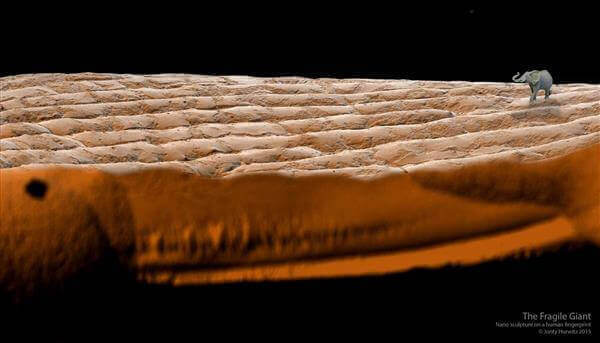The poaching of elephants is rapidly increasing. New, these huge mammals have a new supporter, raising attention in an exceptional way.
Jonty Hurwitz, a London based artist, has begun a new project which he hopes will draw attention to the problem of poaching, specificallypoaching of elephants. For this purpose, he 3D printed an elephant which is just a tenth of a millimeter tall, using nanoscale 3D printing techniques.
This is just one of a series of 3D printing projects by the artist. All of his nanosculptures are 3D printed in a photosensitive material. They are minute enough to fit through the eye of a needle, as small as a speck of dust which could disappear in the wind, and so tiny that they make the ridges on your fingerprints look like their own outdoor terrain.
However, Hurwitz is not just focusing on the technology he needs to create these elephants, but also on the important message he is hoping to send.
The problem of poaching
Referring to a National Geographic article from 2014, he states on his website that African elephant killing is reaching unprecedented levels and is going on at a rate that will quickly make the animal extinct. “Ivory-seeking poachers have killed 100,000 African elephants in just three years, according to a new study that provides the first reliable continent-wide estimates of illegal kills,” he states.”We have come so far! We can place a microscopic elephant between the grooves of a human fingerprint, but we don’t seem able to save the species from our own hands.”
How was the 3D printed elephant created?
In order to complete the complex fabrication, Scientists Stefan Hengsbach and Florian Rupp of the Institute of Microstructure Technology, of the Karlsruhe Institute of Technology in Germany helped with the science required. “The structure is created using a ground-breaking new 3D printing technology and a technique called Multiphoton Lithography. Ultimately these works are created using the physical phenomenon of two photon absorption. Art, literally created with Quantum Physics,” Hurwitz said.
This photon absorption process only happens on a single point, creating a tiny 3D pixel (or a voxel). This process is repeated over and over, merging layer by layer and pixel by pixel in order to create the detailed elephant. The process lasts many hours and through a computer-controlled mechanism, the sculpture grows only by a tiny fraction at a time.
In order to capture the miniscule sculpture on camera, Hurwitz and his team had to use a tool called a Scanning Electron Microscope. “At high magnification, hundreds of images of the nano sculpture were captured as a piezo stage was rotated to a precision of below one ten thousandth of a degree,” he says. “Each individual frame in the sequence can take several minutes to capture (depending on resolution), meaning that one second of film can take up to 4 hours to film. A painstakingly detailed process, in which any micro-blip means starting again from scratch.”
Do you think this miniature art could help the elephant population?
License: The text of "Tiny A 3D Printed Elephant Highlights Huge Poaching Problem" by All3DP is licensed under a Creative Commons Attribution 4.0 International License.
